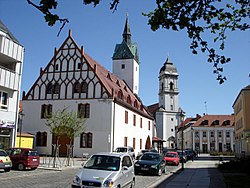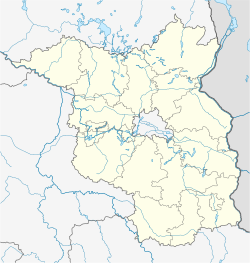world.wikisort.org - Germany
Fürstenwalde/Spree (German pronunciation: [ˈfʏʁstn̩ˌvaldə] (![]() listen); Lower Sorbian: Pśibor pśi Sprjewje)[3] is the most populous town in the Oder-Spree District of Brandenburg, Germany.
listen); Lower Sorbian: Pśibor pśi Sprjewje)[3] is the most populous town in the Oder-Spree District of Brandenburg, Germany.
Fürstenwalde/Spree | |
|---|---|
Town | |
 Town hall and Cathedral | |
 Coat of arms | |
Location of Fürstenwalde/Spree within Oder-Spree district  | |
 Fürstenwalde/Spree  Fürstenwalde/Spree | |
| Coordinates: 52°22′N 14°04′E | |
| Country | Germany |
| State | Brandenburg |
| District | Oder-Spree |
| Subdivisions | City center and 4 districts |
| Government | |
| • Mayor (2018–26) | Matthias Rudolph[1] |
| Area | |
| • Total | 70.55 km2 (27.24 sq mi) |
| Elevation | 43 m (141 ft) |
| Population (2020-12-31)[2] | |
| • Total | 31,992 |
| • Density | 450/km2 (1,200/sq mi) |
| Time zone | UTC+01:00 (CET) |
| • Summer (DST) | UTC+02:00 (CEST) |
| Postal codes | 15517 |
| Dialling codes | 03361 |
| Vehicle registration | LOS |
| Website | https://www.fuerstenwalde-spree.de/ |
Geography
The town is situated in the glacial valley (Urstromtal) of the Spree river north of the Rauen Hills, about 60 km (37 mi) east of Berlin and 30 km (19 mi) west of Frankfurt (Oder). The district capital Beeskow is about 25 km (16 mi) to the southeast. In the north, the municipal area comprises the village of Trebus. The town is located on the western part of historic Lubusz Land (Land Lebus).
The Fürstenwalde station is a stop on the railway line from Berlin to Frankfurt (Oder), the former Lower Silesian-Marcher Railway. It also has access to the parallel Bundesautobahn 12. The 39 MW Fürstenwalde Solar Park supplies electricity to the local grid.
History
The settlement of Fürstenwalde in the Margraviate of Brandenburg was first mentioned in a 1272 deed, founded in the course of the German Ostsiedlung migration at a ford across the Spree river, probably near the site of a former Slavic settlement. The Lebus Land had been acquired from Poland by the Ascanian margraves in 1248/1249. The town's importance rose as a staple port and terminal of the transportation of goods on the river.
In 1373 Emperor Charles IV, since 1367 also Margrave of adjacent Lower Lusatia campaigned the Brandenburg lands and enforced the renunciation of the Wittelsbach margrave Otto VII of Brandenburg by the Treaty of Fürstenwalde. As also the collegiate church in Lebus was destroyed, Bishop Wenceslaus moved the official seat of the Bishopric of Lebus to Fürstenwalde, where the St Mary's Church was raised to a cathedral.
The last Catholic bishop was Georg von Blumenthal (1490–1550), who was besieged in his palace by Lutheran robbers led by Nickel von Minckwitz. The Bishop had to escape through a window in disguise. The bishopric was secularized during the Reformation in 1555, and was completely disbanded at the ascension of Joachim Frederick as Margrave of Brandenburg in 1598.
Demography
 Development of Population since 1875 within the Current Boundaries (Blue Line: Population; Dotted Line: Comparison to Population Development of Brandenburg state; Grey Background: Time of Nazi rule; Red Background: Time of Communist rule)
Development of Population since 1875 within the Current Boundaries (Blue Line: Population; Dotted Line: Comparison to Population Development of Brandenburg state; Grey Background: Time of Nazi rule; Red Background: Time of Communist rule) Recent Population Development and Projections (Population Development before Census 2011 (blue line); Recent Population Development according to the Census in Germany in 2011 (blue bordered line); Official projections for 2005–2030 (yellow line); for 2017–2030 (scarlet line); for 2020–2030 (green line)
Recent Population Development and Projections (Population Development before Census 2011 (blue line); Recent Population Development according to the Census in Germany in 2011 (blue bordered line); Official projections for 2005–2030 (yellow line); for 2017–2030 (scarlet line); for 2020–2030 (green line)
|
|
|
Politics
Seats in the town's assembly (Stadtverordnetenversammlung) as of 2014 local elections:
- The Left: 7
- Christian Democratic Union of Germany (CDU): 6
- Social Democratic Party of Germany (SPD): 6
- Free Voters (BFZ): 5
- Free Democratic Party (FDP): 3
- Alternative for Germany (AfD): 2
- Alliance 90/The Greens: 2
- Pirate Party Germany: 1
Twin towns – sister cities
Fürstenwalde is twinned with:[5]
Notable people

- Karl Friedrich Schulz (1784–1850), Protestant composer and music teacher
- Julius Pintsch (1815–1884), founder of the former industrial company Julius Pintsch AG Berlin-Fürstenwalde
- Ernst Laas (1837–1885), pedagogue and philosopher
- Max Valentin (1875–1920), sculptor and architect
- Wilhelm Burgdorf (1895–1945), general of the infantry
- Wolfgang Götze (born 1937), theoretical physicist
- Hans-Michael Rehberg (1938–2017), actor and film director
- Ludolf von Wartenberg (born 1941), politician, member of Bundestag
- Helmut Panke (born 1946), manager
- Burkhard Reich (born 1964), footballer
- Axel Schulz (born 1968), boxer
References
- Landkreis Oder-Spree Wahl der Bürgermeisterin / des Bürgermeisters, accessed 2 July 2021.
- "Bevölkerung im Land Brandenburg nach amtsfreien Gemeinden, Ämtern und Gemeinden 31. Dezember 2020". Amt für Statistik Berlin-Brandenburg (in German). June 2021.
- Sophie Wauer, Klaus Müller: "Die Ortsnamen des Kreises Beeskow-Storkow", pp. 226–228
- Detailed data sources are to be found in the Wikimedia Commons.Population Projection Brandenburg at Wikimedia Commons
- "Städtepartnerschaften". fuerstenwalde-spree.de (in German). Fürstenwalde/Spree. Retrieved 2021-03-05.
External links
 Media related to Fürstenwalde/Spree at Wikimedia Commons
Media related to Fürstenwalde/Spree at Wikimedia Commons- . Encyclopedia Americana. 1920.
- Official website (in German)
- History of Fürstenwalde (in German)
На других языках
[de] Fürstenwalde/Spree
Fürstenwalde/Spree [.mw-parser-output .IPA a{text-decoration:none}fʏʁstn̩ˈvaldə] ist die bevölkerungsreichste Stadt im Landkreis Oder-Spree im Osten des Landes Brandenburg. Sie ist ein wichtiges Verwaltungs- und Wirtschaftszentrum.- [en] Fürstenwalde
[es] Fürstenwalde
Fürstenwalde es una localidad en el distrito de Oder-Spree de Brandeburgo, Alemania. Se sitúa a 55 kilómetros de Berlín. Se divide en cuatro barrios.[ru] Фюрстенвальде (Шпре)
Фюрстенвальде (нем. Fürstenwalde/Spree), польск. Пшибор (Przybór) — город в Германии, в земле Бранденбург.Другой контент может иметь иную лицензию. Перед использованием материалов сайта WikiSort.org внимательно изучите правила лицензирования конкретных элементов наполнения сайта.
WikiSort.org - проект по пересортировке и дополнению контента Википедии


